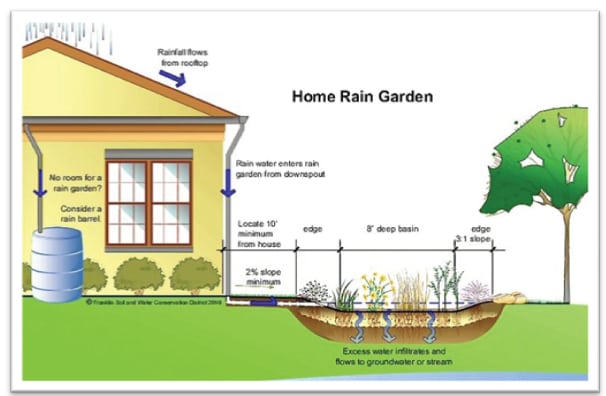Harvest More Rain in the Landscape with Rain Gardens
A rain garden is a planted depression in the soil which slows and infiltrates rainwater before it becomes polluted and erosive stormwater runoff. Usually, it is a small garden shaped like a shallow pool or ditch, which collects rainwater from a roof, roadway, or nearby hard surface. The plants are chosen to withstand extremes of moisture, as they may be in standing water for parts of winter and then must survive summers with very little moisture. The plants help absorb and infiltrate the water, so are critical component of a functional rain garden. Ideally, your rain gardens will be sited close to the source of the runoff and serve to slow the stormwater as it travels downhill, giving the stormwater more time to infiltrate and less opportunity to gain momentum and erosive power. It encourages water to walk across the landscape rather than run off. Rain gardens not only keep our waterways healthier, but they also recharge your soil with high quality water that your plants will love!
With a planted depression or a hole, a rain garden takes full advantage of scarce resources with the opportunity to be absorbed, integrated, and saved.
Design Considerations for Rain Gardens
Rain Gardens are best placed near the source of runoff although with enough margin so as to not cause damage to the foundation of the structure. Here are some other tips to consider when designing your rain garden:
- Avoid damage to roots and foundations; place gardens a minimum of 10’ away from any structure or shallow-rooted trees.
- Maintain a 3:1 or 2% slope until you reach the “edge” of the 8-12” basin to allow water to pool and percolate, preventing erosion.
- Keep it away from your septic system and drain field, rights of way, and underground utilities or service lines to avoid damage and contamination.
- Place in in full or partial sun, so as to ensure evaporation in the event of excess water pooling.
Benefits of Rain Gardens
There are many benefits to the installation of a rain garden on your property, including increasing your property value. Here are a few more to consider:
- Reduce the amount of polluted stormwater reaching our rivers
- Filter pollutants such as oil, fertilizers, salt, pesticides, metals and bacteria out of runoff
- Promote infiltration and recharge of the groundwater table
- Reduce local flooding potential
- Conserve water
- Create diverse habitat for birds and butterflies
- Reduce landscape maintenance in terms of time and money
Ideal Plants for Home Rain Gardens
Plants with deep fibrous roots tend to have a competitive advantage in a rain garden and provide the most cleaning and filtration benefits to the environment. Rain gardens are typically populated with natives or native cultivars as these are most well adapted to a locality. Listed below are a few great examples for our region to help you get started:
Grasses
Carex tumulicola- Berkeley Sedge
Juncus patens –Common Rush
Muhlenbergia – Deer Grass
Stipapulchra – Purple Needle Grass (California State Grass)
Shrubs
Solidagospathulata- California Goldenrod
Eriogonumsp.–CA. Buckwheat
Mimulusaurantiacus – Sticky Monkeyflower
Epilobiumcanum – California Fuchsia
Lupinusalbifrons – Silver Bush Lupine
Sambucusnigra– Blue Elderberry
Here’s another great article that sums up just what a rain garden is and how to properly tend to one:
A Guide to Building and Maintaining a Self-Sufficient Rain Garden


